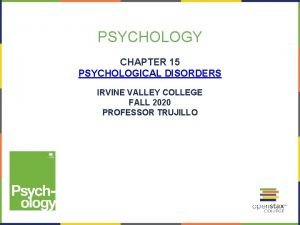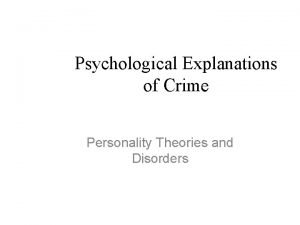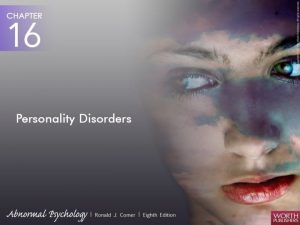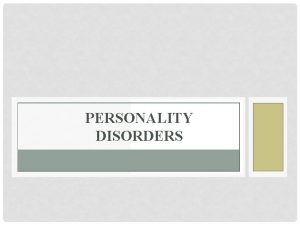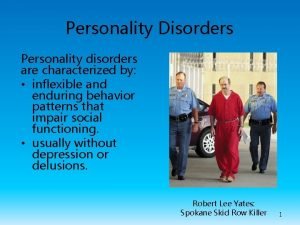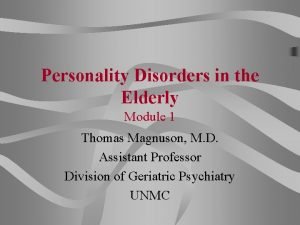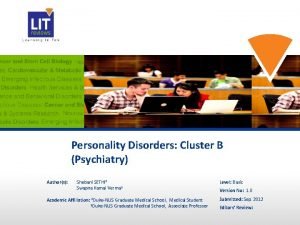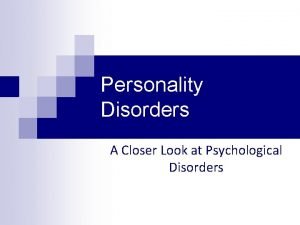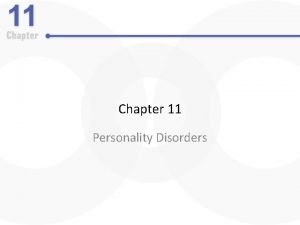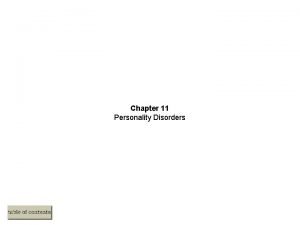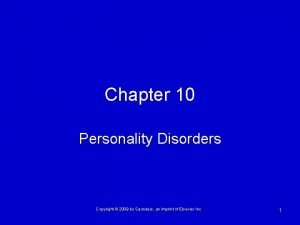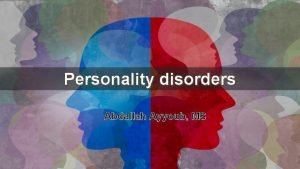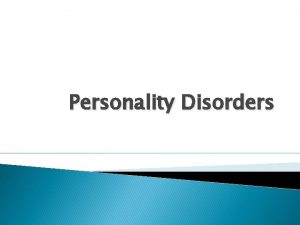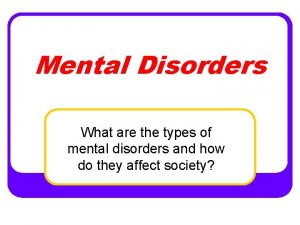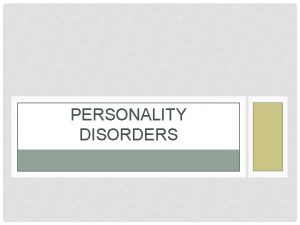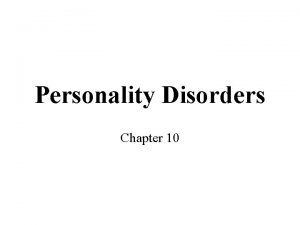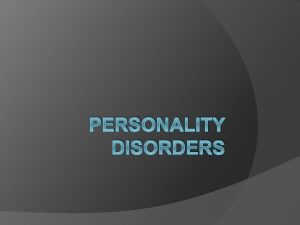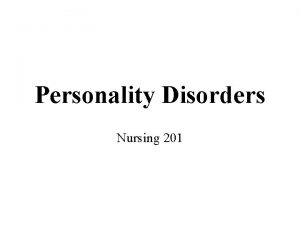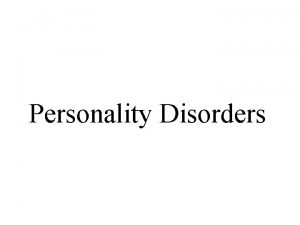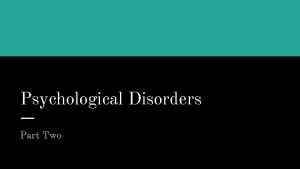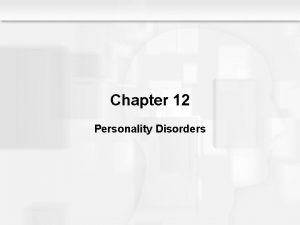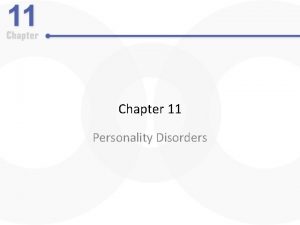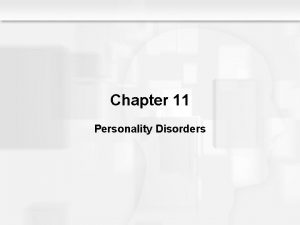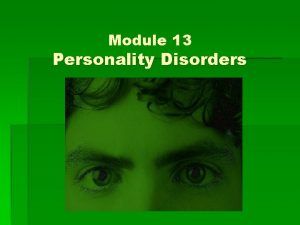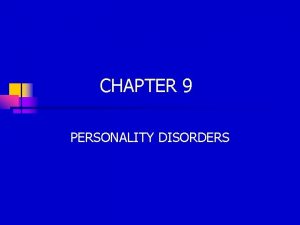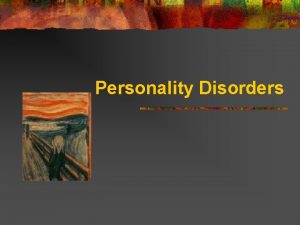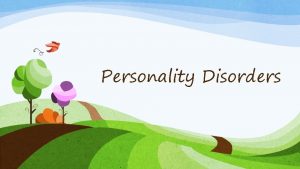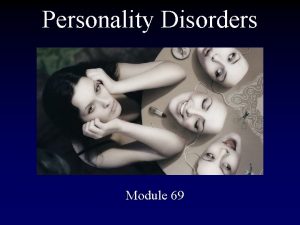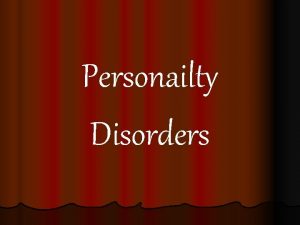Chapter 11 Personality Disorders Personality Disorders An Overview

































- Slides: 33

Chapter 11 Personality Disorders

Personality Disorders: An Overview • The nature of personality disorders – Enduring and relatively stable predispositions – Inflexible and maladaptive, causing distress and/or impairment – Coded on Axis II of the DSM-IV-TR • Categorical vs. dimensional models of personality disorders

Personality Disorders: An Overview • DSM-IV-TR personality disorder clusters – Cluster A – odd or eccentric cluster – Cluster B – dramatic, emotional, erratic cluster – Cluster C – fearful or anxious cluster

Personality Disorders: Statistics • Prevalence of personality disorders – Affects about 0. 5% to 2. 5% of the general population – 10% to 30% inpatients – Rates are higher in inpatient and outpatient settings • Origins and course of personality disorders – Thought to begin in childhood – Tend to run a chronic course if untreated – Comorbidity rates are high

Personality Disorders: Facts and Statistics (continued) • Gender distribution and gender bias in diagnosis – Gender bias exists in the diagnosis • Antisocial – male • Histrionic - female – Criterion and/or assessment gender bias • Comorbidity • Personality disorders under study – Sadistic, depressive and passive-aggressive


Cluster A: Paranoid Personality Disorder • Overview and clinical features – Pervasive and unjustified mistrust and suspicion • The causes – Biological and psychological contributions are unclear – Early learning that people and the world is a dangerous place

Cluster A: Paranoid Personality Disorder • Treatment options – Few seek professional help on their own – Treatment focuses on development of trust – Cognitive therapy to counter negativistic thinking – Lack of good outcome studies

Cluster A: Schizoid Personality Disorder • Overview and clinical features – Pervasive pattern of detachment from social relationships – Very limited range of emotions in interpersonal situations • The causes – Etiology is unclear – Childhood shyness – Preference for social isolation resembles autism

Cluster A: Schizoid Personality Disorder • Treatment options – Few seek professional help on their own – Focus on the value of interpersonal relationships – Building empathy and social skills – Lack of good outcome studies

Cluster A: Schizotypal Personality Disorder • Overview and clinical features – Behavior and dress is odd and unusual – Socially isolated and highly suspicious – Magical thinking, ideas of reference, and illusions – Many meet criteria for major depression

Cluster A: Schizotypal Personality Disorder • The causes – A phenotype of a schizophrenia genotype? – More generalized brain deficits • Treatment options – 30% TO 50% meet the criteria for major depressive disorder – Main focus is on developing social skills – Address comorbid depression – Medical treatment is similar to that used for schizophrenia – Treatment prognosis is generally poor

Cluster B: Antisocial Personality Disorder • Overview and clinical features – Failure to comply with social norms – Violation of the rights of others – Irresponsible, impulsive, and deceitful – Lack of a conscience, empathy, and remorse – Other names – moral insanity, egopathy, sociopathy and psychopathy • Psychopathy and antisocial personality disorder

Cluster B: Antisocial Personality Disorder • Relation with conduct disorder and early behavior problems – Early histories of behavioral problems, including conduct disorder – Families with inconsistent parental discipline and support – Families often have histories of criminal and violent behavior


Neurobiological Contributions and Treatment of Antisocial Personality • Prevailing neurobiological theories – Underarousal hypothesis – cortical arousal is too low – Cortical immaturity hypothesis – cerebral cortex is not fully developed – Fearlessness hypothesis – fail to respond to danger cues – Gray’s model of behavioral inhibition and activation

Neurobiological Contributions and Treatment of Antisocial Personality • Treatment – Few seek treatment on their own – Antisocial behavior is predictive of poor prognosis – Emphasis is placed on prevention and rehabilitation – Often incarceration is the only viable alternative

Neurobiological Contributions and Treatment of Antisocial Personality • Conduct disorder – Genetic influences – Neurobiological influences – Psychological and social dimensions – Developmental influences – An integrative model – Treatment and prevention


Cluster B: Borderline Personality Disorder • Overview and clinical features – Unstable moods and relationships – Impulsivity, fear of abandonment, very poor selfimage – Self-mutilation and suicidal gestures – Comorbidity rates are high

Cluster B: Borderline Personality Disorder • The causes – Runs in families – Early trauma and abuse seem to play some etiologic role • An integrative model • Treatment options – few good outcome studies – Antidepressant medications provide some shortterm relief – Dialectical behavior therapy is most promising treatment

Cluster B: Histrionic Personality Disorder • Overview and clinical features – Overly dramatic, sensational, and sexually provocative – Often impulsive and need to be the center of attention – Thinking and emotions are perceived as shallow – Common diagnosis in females

Cluster B: Histrionic Personality Disorder • The causes – Etiology is largely unknown: Variant of antisocial personality? • Treatment options – Focus on attention seeking and long-term negative consequences – Targets may also include problematic interpersonal behaviors – Little evidence that treatment is effective

Cluster B: Narcissistic Personality Disorder • Overview and clinical features – Exaggerated and unreasonable sense of selfimportance – Preoccupation with receiving attention – Lack sensitivity and compassion for other people – Highly sensitive to criticism; envious, and arrogant

Cluster B: Narcissistic Personality Disorder • The causes – Failure to learn empathy as a child – Sociological view – product of the “me” generation • Treatment options – Focus on grandiosity, lack of empathy, unrealistic thinking – Little evidence that treatment is effective

Cluster C: Avoidant Personality Disorder • Overview and clinical features – Extreme sensitivity to the opinions of others – Highly avoidant of most interpersonal relationships – Are interpersonally anxious and fearful of rejection – Low self esteem

Cluster C: Avoidant Personality Disorder • The causes – Numerous factors have been proposed – Difficult temperament and early rejection • Treatment options – Several well-controlled treatment outcome studies exist – Treatment is similar to that used for social phobia – Treatment targets include social skills and anxiety

Cluster C: Dependent Personality Disorder • Overview and clinical features – Reliance on others to make major and minor life decisions – Unreasonable fear of abandonment – Clingy and submissive in interpersonal relationships

Cluster C: Dependent Personality Disorder • The causes – Still largely unclear – Linked to early disruptions in learning independence • Treatment options – Research on treatment efficacy is lacking – Therapy typically progresses gradually – Treatment targets include skills that foster independence

Cluster C: Obsessive-Compulsive Personality Disorder • Overview and clinical features – Excessive and rigid fixation on doing things the right way – Highly perfectionistic, orderly, and emotionally shallow – Obsessions and compulsions are rare

Cluster C: Obsessive-Compulsive Personality Disorder • The causes: – Are largely unknown – Weak genetic link • Treatment options – Data supporting treatment are limited – Address fears related to the need for orderliness – Rumination, procrastination, and feelings of inadequacy

Summary of Personality Disorders • Personality disorders – Long-standing patterns of behavior – Begin early in development and run a chronic course • Disagreement exists over how to categorize personality disorders – Categorical vs. dimensional, or some combination of both

Summary of Personality Disorders • DSM-IV-TR includes 10 personality disorders – Fall into cluster A, B, or C • The causes of personality disorders – Start in childhood, but are difficult to specify • Treatment is difficult and prognosis poor
 Diathesis stress model
Diathesis stress model Cluster b personality disorder
Cluster b personality disorder Avoidant personality traits
Avoidant personality traits Dsm v personality disorders
Dsm v personality disorders Inflexible personality
Inflexible personality Cluster c personality disorder
Cluster c personality disorder Cluster b personality traits
Cluster b personality traits Schizotypal personality disorder
Schizotypal personality disorder Class a personality disorders
Class a personality disorders Cluster b personality disorder
Cluster b personality disorder Mnemonic for antisocial personality disorder
Mnemonic for antisocial personality disorder Cluster b personality disorders
Cluster b personality disorders Weird wild wacky personality disorders
Weird wild wacky personality disorders Type c personality disorder
Type c personality disorder Personality disorder types
Personality disorder types Emt chapter 24 trauma overview
Emt chapter 24 trauma overview Emt chapter 14 medical overview
Emt chapter 14 medical overview Chapter 9 lesson 2 photosynthesis an overview
Chapter 9 lesson 2 photosynthesis an overview Chapter 12 selling overview
Chapter 12 selling overview Chapter 2 an overview of the financial system
Chapter 2 an overview of the financial system Chapter 1 overview of verb tenses
Chapter 1 overview of verb tenses Overview of personal finance chapter 1
Overview of personal finance chapter 1 Tooth numbering system in usa
Tooth numbering system in usa Personal finance chapter 1 review answers
Personal finance chapter 1 review answers General features of animals
General features of animals Chapter 1 an overview of financial management
Chapter 1 an overview of financial management Elements and their properties section 1 metals
Elements and their properties section 1 metals Chapter 1 overview of financial statement analysis
Chapter 1 overview of financial statement analysis Chapter 18 psychological disorders review worksheet
Chapter 18 psychological disorders review worksheet Concept mapping chapter 11 genetic disorders
Concept mapping chapter 11 genetic disorders Chapter 8 skin disorders and diseases
Chapter 8 skin disorders and diseases Chapter 6 musculoskeletal system diseases and disorders
Chapter 6 musculoskeletal system diseases and disorders Chapter 46 digestive and endocrine disorders
Chapter 46 digestive and endocrine disorders Types of somatic disorder
Types of somatic disorder
